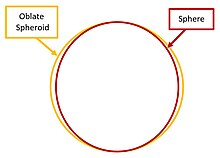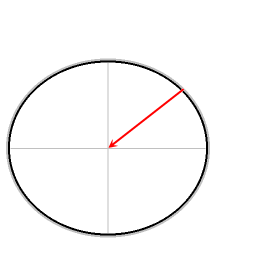Equatorial bulge
This article needs additional citations for verification. (April 2023) |
An equatorial bulge is a difference between the

On Earth
The planet Earth has a rather slight equatorial bulge; its equatorial diameter is about 43 km (27 mi) greater than its polar diameter, with a difference of about 1⁄298 of the equatorial diameter. If Earth were scaled down to a globe with an equatorial diameter of 1 metre (3.3 ft), that difference would be only 3 mm (0.12 in). While too small to notice visually, that difference is still more than twice the largest deviations of the actual surface from the ellipsoid, including the tallest mountains and deepest oceanic trenches.
The difference of the radii is thus about 21 km (13 mi). An observer standing at sea level on either pole, therefore, is 21 km (13 mi) closer to Earth's center than if standing at sea level on the Equator. As a result, the highest point on Earth, measured from the center and outwards, is the peak of Mount Chimborazo in Ecuador rather than Mount Everest. But since the ocean also bulges, like Earth and its atmosphere, Chimborazo is not as high above sea level as Everest is. Similarly the lowest point on Earth, measured from the center and outwards, is the Litke Deep in the Arctic Ocean rather than Challenger Deep in the Pacific Ocean. But since the ocean also flattens, like Earth and its atmosphere, Litke Deep is not as low below sea level as Challenger Deep is.
More precisely, Earth's surface is usually approximated by an ideal
The equilibrium as a balance of energies

Gravity tends to contract a celestial body into a sphere, the shape for which all the mass is as close to the center of gravity as possible. Rotation causes a distortion from this spherical shape; a common measure of the distortion is the flattening (sometimes called ellipticity or oblateness), which can depend on a variety of factors including the size, angular velocity, density, and elasticity.
A way for one to get a feel for the type of equilibrium involved is to imagine someone seated in a spinning swivel chair and holding a weight in each hand; if the individual pulls the weights inward towards them, work is being done and their rotational kinetic energy increases. The increase in rotation rate is so strong that at the faster rotation rate the required centripetal force is larger than with the starting rotation rate.
Something analogous to this occurs in planet formation. Matter first coalesces into a slowly rotating disk-shaped distribution, and collisions and friction convert kinetic energy to heat, which allows the disk to self-gravitate into a very oblate spheroid.
As long as the proto-planet is still too oblate to be in equilibrium, the release of gravitational potential energy on contraction keeps driving the increase in rotational kinetic energy. As the contraction proceeds, the rotation rate keeps going up, hence the required force for further contraction keeps going up. There is a point where the increase of rotational kinetic energy on further contraction would be larger than the release of gravitational potential energy. The contraction process can only proceed up to that point, so it halts there.
As long as there is no equilibrium there can be violent convection, and as long as there is violent convection friction can convert kinetic energy to heat, draining rotational kinetic energy from the system. When the equilibrium state has been reached then large scale conversion of kinetic energy to heat ceases. In that sense the equilibrium state is the lowest state of energy that can be reached.
The Earth's rotation rate is still slowing down, though gradually, by about two thousandths of a second per rotation every 100 years.[1] Estimates of how fast the Earth was rotating in the past vary, because it is not known exactly how the moon was formed. Estimates of the Earth's rotation 500 million years ago are around 20 modern hours per "day".
The Earth's rate of rotation is slowing down mainly because of tidal interactions with the Moon and the Sun. Since the solid parts of the Earth are
Effect on gravitational acceleration

Red arrow: gravity
Green arrow: the normal force
Blue arrow: the resultant force
The resultant force provides required centripetal force. Without this centripetal force frictionless objects would slide towards the equator.
In calculations, when a coordinate system is used that is co-rotating with the Earth, the vector of the notional centrifugal force points outward, and is just as large as the vector representing the centripetal force.
Because of a planet's rotation around its own axis, the
At the poles, the gravitational acceleration is 9.8322 m/s2. The difference of 0.0178 m/s2 between the gravitational acceleration at the poles and the true gravitational acceleration at the Equator is because objects located on the Equator are about 21 km (13 mi) further away from the center of mass of the Earth than at the poles, which corresponds to a smaller gravitational acceleration.
In summary, there are two contributions to the fact that the effective gravitational acceleration is less strong at the equator than at the poles. About 70% of the difference is contributed by the fact that objects circumnavigate the Earth's axis, and about 30% is due to the non-spherical shape of the Earth.
The diagram illustrates that on all latitudes the effective gravitational acceleration is decreased by the requirement of providing a centripetal force; the decreasing effect is strongest on the Equator.
Effect on satellite orbits
The fact that the Earth's gravitational field slightly deviates from being spherically symmetrical also affects the orbits of
Such perturbations, which were earlier used to map the Earth's gravitational field from space,[6] may play a relevant disturbing role when satellites are used to make tests of general relativity[7] because the much smaller relativistic effects are qualitatively indistinguishable from the oblateness-driven disturbances.
Formulation
The flattening coefficient for the equilibrium configuration of a self-gravitating spheroid, composed of uniform density incompressible fluid, rotating steadily about some fixed axis, for a small amount of flattening, is approximated by:[8]
where
- is the universal gravitational constant,
- is the mean radius,
- and are respectively the equatorial and polar radius,[dubious ]
- is the rotation period and is the angular velocity,
- is the body density and is the total body mass.
Real flattening is smaller due to mass concentration in the center of celestial bodies.
| ae [km] | ap [km] | freal | T [h] | M [1026 kg] | fformula | |
|---|---|---|---|---|---|---|
| Jupiter | 71,492 | 66,854 | 0.066 | 9.9 | 18.98 | 0.104 |
| Saturn | 60,268 | 54,364 | 0.108 | 10.6 | 5.68 | 0.178 |
| Uranus | 25,559 | 24,973 | 0.023 | 17.2 | 0.87 | 0.036 |
| Neptune | 24,764 | 24,341 | 0.017 | 16.1 | 1.02 | 0.032 |
See also
- Astronomical object § Shape
- Clairaut's theorem (gravity)
- Earth's gravity
- Planetary flattening
References
- ^ Hadhazy, Adam. "Fact or Fiction: The Days (and Nights) Are Getting Longer". Scientific American. Retrieved 5 December 2011.
- S2CID 118305813.
- S2CID 120030309.
- S2CID 119537102.
- .
- .
- .
- ^ "Rotational Flattening". utexas.edu.










